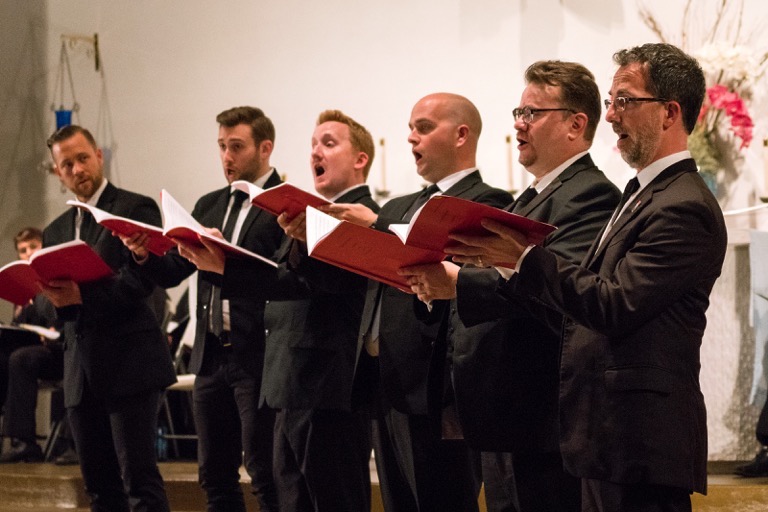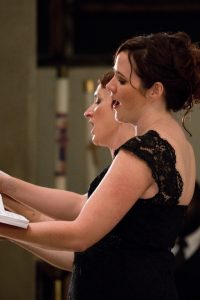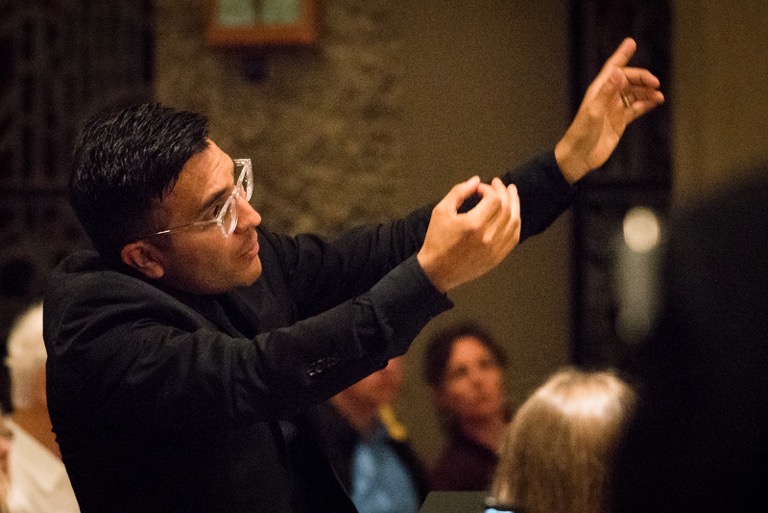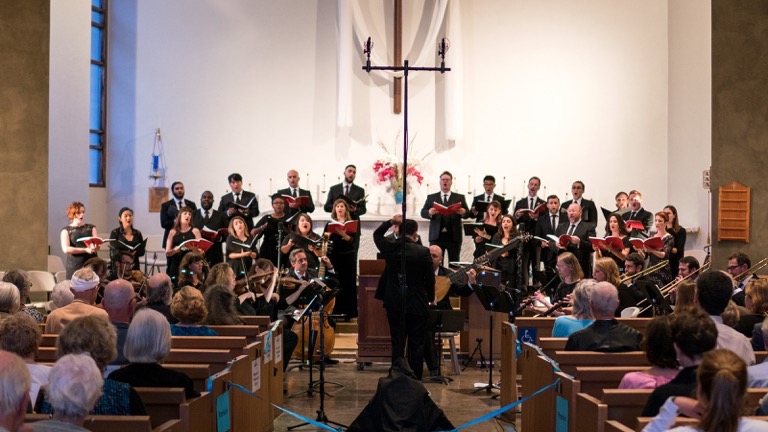Monteverdi’s Glorious “Vespro della Beata Vergine” with the Bach Collegium
Claudio Monteverdi’s Vespro della Beata Vergine 1610
(Vespers for the Blessed Virgin, 1610)
or Vespers of 1610
Bach Collegium San Diego
Ruben Valenzuela, music director
with the Tesserae Brass
and the San Diego State University Choir
Performed in two parts with one intermission:
Friday, May 13, at 7:30 p.m. at St. Andrew’s by-the-Sea Episcopal Church, Pacific Beach
Saturday, May 14, at 7:30 p. m. at All Saints’ Episcopal Church, Hillcrest (Reviewed here.)
Review by David Gregson, May 14, 2016
So — why all the cornetts and sackbuts at Opera West? Not to mention a theorbo?
People often ask me, “What is your favorite opera?” Sometimes I say, “All of them,” shorthand for the jaded critic’s favorite answer, “Whichever one I am listening to at the present time.” But sometimes I feel a bit show-offy and I say, Il ritorno d’Ulisse in patria, firing off all 13 syllabus, stressing each one equally like a machine gun.
“Who wrote that?” they’ll say.
“Monteverdi. It means The Return of Ulysses to his Homeland. It’s based on Homer’s The Odyssey.
“It’s by Giuseppe Verdi you say?”
“No, the other one. Claudio Monteverdi. He was the earliest and the greatest opera composer that we still listen to with any frequency today. He virtually invented opera. He wrote this wonderful piece back in 1640, and to my mind, it has rarely been surpassed. Much of it is profoundly moving, but it is Shakespearean in scope, embracing the high and low, gods and men and women of all classes. And, I might add, I am also nuts about L’Orfeo and L’incoronazione di Poppea.”
And I am not joking. Nonetheless, most of my fellow opera fiends are not really into early music at all. Puccini, Wagner, Strauss, Mozart and Verdi do not scoot over in their pantheon to make room for Monteverdi as a general rule.
I personally came to opera only gradually. J. S. Bach was my first passionate love. In high school I collected Bach recordings — all the keyboard works, the cantatas, passions, the great B Minor Mass, and everything else. (Stravinsky fits in here somewhere as a stark contrast.) Then I discovered Mozart, Puccini and Verdi. Many years later I even became a Wagnerian who called Tristan the greatest art work of the 19th century. Tristan und Isolde was my “favorite opera” response for a decade or so — until I got tired of saying so. Today I want to hear more Handel, more Rameau, more Lully. So I am a goner. Rameau? Really? Yep!
Thus, when an excellent institution such as the Bach Collegium San Diego announces it’s offering Monteverdi’s Vespers of 1610, a cornerstone baroque masterpiece, I’d say, Opera West needs to be there. Verdi’s Messa da Requiem isn’t an opera either — technically — but I have covered that work several times at this website. Of course, it’s really “Verdi’s greatest opera” — not an original observation, but a good one.
A key to appreciating almost all of Monteverdi’s music, operatic or not, is paying attention to the words — the astonishing way the composer sets his texts. The operas may “sound all the same” if one does not do this. Of course, the Vespers sweeps one away just by virtue of the stunning polyphony and antiphonal effects alone. The stunning solo vocal parts require highly capable virtuosi to do them justice. But one must follow the Latin words and listen what happens to them. The amount of invention is astonishing, as is the sensitivity to meaning.

Soloists Derek Chester, Scott Mello,
Erik Gustafson, Kyle Ferrill, Jeff Fields, Patrick Walders (not necessarily in that order L to R). Photo by Gary Payne.
The wonderful texts of the Vespers, however, add up to an odd assortment of different things that may not have been intended for a single performance. In sequence, the end of the Vespers is a carefully wrought Magnificat (using the same text J.S. Bach used for his great piece of the same name), and the entire work opens with a memorable “Versicle and Response” that echoes the grand opening of L’ Orfeo (1607). One soon becomes aware of two Monteverdis: one the master of monody and the other a master of polyphony. This is manifest throughout the pieces the comprise the Vespers.
The main body of the piece alternates five psalms and four motets, with the addition of the Hymn (Ave maris stella) and the remarkable Sonata sopra Santa Maria Sancta Maria, ora pro nobis for sopranos and instruments. For the latter in Sunday’s performance, the women marched down a side aisle to the back of the church and sang in unison, while up front, the instrumentalists dazzled their more-than-merry way through the music.
This was only one instance, however, of a living surround sound spectacular. The motet Duo Seraphim (“Two angels were calling one to the other” adapted from Isaiah 6:2-3 and 1 John 5:7) is a vocal duet that becomes “three in one” symbolically, and the performances here of the tenor soloists are now memories to be treasured. The motet Audi coelum was also magical, with haunting responses coming seemingly from nowhere and echoing about the room.
Who was what and who was where was extremely difficult to determine for Opera West, for even though I arrived a half-hour early, I was only able to find a seat in the 15th row of church pews, and so the orchestra remained virtually invisible to me. I spotted a cornett player at one point during the closing Magnificat, because she had moved further upstage, as it were. I could see the long-necked theorbo and two string players, but I only heard the sackbuts (early trombones). For the lady on my right, the instrumentalists and chorus were totally out of any possible sightline. When soloists entered the pulpit on high, then we could all see them, of course. The reader will understand, I hope, that it is impossible to correctly identify artists if you really are not at all certain what they look like. A “comments” section at the bottom of this page exists partly so Opera West can be blessedly freed from the Grip of Monster Error.
I can attest, however, that seen and unseen, all the soloists were exceptionally fine, even surprisingly so. I was especially impressed by tenor Derek Chester, and he was well matched by tenors Scott Mello and Eric Gustavson. They sang the aforementioned Duo seraphim section. Additional luster came elsewhere from sopranos Stefanie Moore, Melanie Russell, and Anne-Marie Dicce. Molly Quinn and Moore glowed in the motet “Pulchra est” from the Song of Songs.
The Song of Songs? Indeed, something of the sacred and the profane seem to combine in the Vepsers, a meeting of the Heavenly and the Earthly Venus directly out of the Neoplatonic imagination. It is the secret, I think, of Monteverdi’s seductive power.
The chorus sounded so glorious that there might as well have been 100 of the them rather than a select few. The visiting Tesserae Brass were striking in their total mastery of the period instruments, the cornett and sackbut. And absolutely everybody under the inspired musical guidance of Ruben Valenzuela must be commended for a memorable Vespers performance, the second the Bach Collegium has offered since 2010.
***
But soft! A word or two before you go. There is an kind of ornamentation most often associated with Monteverdi known as the trillo, sometimes called the “goat trill.” It is a rapid repetition of a single note — so a word like “sanctus” might be sung with a series of “ha ha ha ha” sounds in the middle of it. I have never been more impressed nor as moved by the trillo as in the “Sanctus Dominus Deus” from the Duo Seraphim motet. It seemed, for once, to have a real meaning.
Scattered notes: I sensed real terror in the “ruinas” neighborhood of the Dixit Dominus, was swept away by the virtuosity of solo singing in the Nigra Sum, felt raised like the helpless from earth in the Laudate pueri, tapped my toes in the Nisi dominus, and felt chills at all the iterations of “Gloria” and “Amen.”
The pre-performance lecture: The Collegium often begins its programs with helpful and quite interesting lectures; however, better cooperation from both the concert goers and the management is needed if these lectures are to be audible. Noise filters in from outside the entrance and people chatter away as they seat themselves.

Sopranos Molly Quinn and Stefanie Moore. Photo by Gary Payne. From the St. Andrew’s evening concert.
PRINCIPAL SOLOISTS:
Nell Snaidas, Soprano
Molly Quinn, Soprano
Stefanie Moore, soprano
Regginald L. Mobley, Countertenor
Derek Chester, Tenor
Scott Mello, Tenor
Kyle Ferrill, Bass
Patrick Walders, Bass
RIPIENO:
Anne-Marie Dicce, soprano
Angela Young Smucker, mezzo-soprano
Clifton Massey, countertenor
Erik Gustafson, tenor
Jeff Fields, baritone
This project includes Bach Collegium’s inaugural apprenticeship program, in which the ensemble is joined by choral students from San Diego State University.


